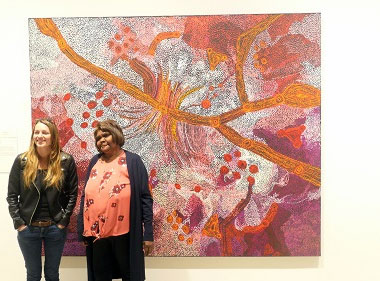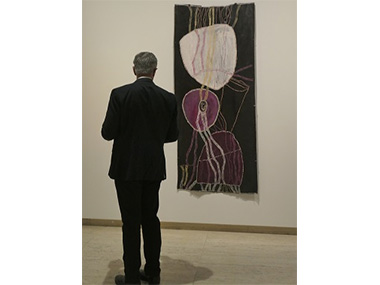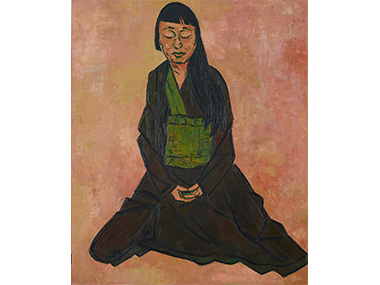WHO'LL WIN THE WYNNE IN 2019?

Syliva Ken, winner of the Wynne, standing in front of her rich 'Seven Sisters' artwork with an admirer
Posted by Jeremy Eccles | 02.05.19
Gallery: Art Gallery of NSW
Dates:
11.05.19
: 08.09.19
It's been 4 years since anyone but an Aboriginal artist has won the country's premier prize for landscape painting – the Art Gallery of NSW's Wynne Prize. And this year may be no different as precisely half of the selected entries (from 683 aspirants) are Aboriginal works – 13 from the APY Lands or Papunya Tula artists, one from the queen of bark, Nonggirrgna Marawili and one by Blak Douglas of Western Sydney.
There's some stunning stuff, ranging from the classic, John-Olsen-on-speed Yaritji Young that hits you in the eye as you enter the ever-popular Archibald, Wynne and Sulman Prizes show to Mantua Nangala's intense, dark sand-hill patterning with unfathomable shades of green peering through. The linked imagery of Wawiriya Burton and Nellie Coulthard hangs side by side. Wititji George and the collaboration of Keith Stevens and Ginger Wikilyiri go to the same place for their grand canvases – the water-hole, Piltati – but tell different stories. “Piltati is a big place; big stories”, more than justifies the coincidence for Keith Stevens. But for all this colour and size, it was hard for me to go past Nonggirrnga's 'Pink Lightning' bark – an advance on her recent AGNSW solo show in that she's found discarded computer print cartridges to add to her colour range. The magenta ink offers a splendid plum tone to her drama of rocks, wild sea and Lightning Snake at Baraltja on the Gulf of Carpentaria.
Can an Indigenous artist win for a fourth year in a row? I must admit that my eyes barely took in the Wynne's non-Indigenous competition – though Glen Clarke's intriguing sculptural work just might break the multi-year drought for three-dimensional works. And there's always the temptation for the AGNSW Trustees to feel that the new Robert Family Prize and Acquisition that's restricted to ATSI entrants may be sufficient reward for all that Aboriginal effort.
It wouldn't be!
Mind you, there's a bit of Indigenous interest in the other two prizes as well. The Archibald is what the world takes by far the most interest in – for the subjects have to be well-known, therefore recognisable, and that doubles up on the fascination, I suppose. Blak Douglas pops up again with a work I half believe could actually win this one. His subject is Aunty Esma Timbery, the now 88-year old mistress of the shell art that's become the iconic product of the Laper (La Perouse) Aboriginal community, and she's in the pink and festooned, appropriately, with shells. Vincent Namatjira has a go at fellow-artist Tony Albert, but I feel his big heart wasn't in it. And that newest scion of the Perkins clan – Thea Anamara – attempts Christian Thompson; but the senior artist's ebullience is strangely absent.
And then a few non-Indigenous artists have tackled Aboriginal subjects. I really like the passion that David Darcy has piled into Daisy Tjuparntarri Ward's huge face. The Warakurna elder's cultural authority is all there; though the predominantly red oxide tone she's adorned with for ceremony may not have quite the authenticity of ochre. Then Kate Gradwell's tidy picture of Prof Michael McDaniel, pro-Vice-Chancellor at UTS, captures him perfectly – possum-skin cloak and all. Thirdly, the renowned Imants Tillers surprises by feting Indigenous footballer Greg Inglis with many a Rabbitoh, a couple of references to Michael Jagamara Nelson and an image of Inglis that seems to lack essential bulk.
Finally, the incomprehensible Sulman Prize for a rag-bag called 'genre' paintings. Kaylene Whiskey won it last year for her naïve pop art, so Sally Mulda surely stands a fair chance with her naïve self-portrait “feeding her cat”. But I'm afraid Joan Ross said something much more interesting and complex to me. In a simple, drawn work on paper, showing a headless man having his chest measured (at 2 feet 10 inches), she creates imagery from Watkin Tench's diary note of 1788 as the English invaders sought to come to terms with the bodies (if not the minds) of their new co-countrymen. It's movingly called 'I Held My Arms Open in Trust (The Measuring of Beneelon/Bennelong)'. Did Tench report such a comment, or is Ross attempting to enter the Gadigal man's mystified mind?
We'll find out who actually wins next Friday, 10th May.
And the answer is that there were a series of left-field prize-winners, generally unpredicted. Sylvia Ken – unmentioned above by me – took out the Wynne Prize from 683 entries! She takes home to Amata in the APY Lands $50,000 and looked a bit bewildered about it all at the announcement today. Her family are traditional owners of several of the sites in the iconic Seven Sisters story, the subject of her intense painting. It was also the subject of the 2016 Wynne winner by five of Sylvia's aunts and the major exhibition at the National Museum which traced this Songline from the WA coastline into the APY deserts.
Gallery director, Michael Brand commented: “This complex work recalls the starry skies of the Milky Way as much as it does the rest of the land where the Seven Sisters story takes place, on Sylvia’s country where her family are the traditional owners.”
So an Aboriginal artist gets the Wynne now for the fourth year in succession; and the newish Roberts Family Prize for an Indigenous artist goes to Noŋgirrŋa Marawili for the glorious bark, 'Pink Lightning' hailed above.
The big $100,000 Archibald Prize for portraiture goes to Tony Costa for a beautifully meditative portrait of fellow-artist, Lindy Lee. And the Sulman Prize went to the “idiosyncratic” (his word) McLean Edwards for another portrait. “Deciding a winner was fraught”, explained the Sulman judge, artist Fiona Lowry; “but it was the sound of McLean Edwards’ 'The first girl that knocked on his door' that I came back to – it reminded me of the heartbreak that love can bring with it and where the end is often in the beginning”.
URL: https://www.artgallery.nsw.gov.au/exhibitions/
Share this:
»  del.icio.us
»
del.icio.us
»  Digg it
»
Digg it
»  reddit
»
reddit
»  Google
»
Google
»  StumbleUpon
»
StumbleUpon
»  Technorati
»
Technorati
»  Facebook
Facebook
Contact Details
Gallery: Art Gallery of NSW
Contact: Cara Pinchbeck - Curator of Aboriginal and Torres Strait Islander Art
Email: artmail@ag.nsw.gov.au
Telephone: +61 2 9225 1700 or 1
Address: Art Gallery Road Sydney Sydney 2000 NSW
Gallery: Art Gallery of NSW
Contact: Cara Pinchbeck - Curator of Aboriginal and Torres Strait Islander Art
Email: artmail@ag.nsw.gov.au
Telephone: +61 2 9225 1700 or 1
Address: Art Gallery Road Sydney Sydney 2000 NSW

Noŋgirrŋa Marawili's bark, 'Pink lightning' (2019) using magenta printing ink to create a new colour for a familiar story

Archibald winner Tony Costa's zen portrait of Lindy Lee
Where is the exhibition?
Further Research
Gallery: Art Gallery of NSW
Artists: | Blak Douglas | Christian Thompson | Esma Timbery | Ginger Wikilyiri | Kaylene Whiskey | Keith Stevens | Mantua Nangala | Michael Jagamara Nelson | Nellie Coulthard | Nonggirrgna Marawili | Sally Mulda | Sylvia Ken | Thea Anamara Perkins | Tony Albert | Vincent Namatjira | Wawiriya Burton | Wititji George | Yaritji Young
News Tags: Archibald Prize | Art Gallery of NSW | Jeremy Eccles | Joan Ross | Ken Sisters | Sulman Prize | Tony Costa | Wynne Prize
News Categories: Art Prize | Australia | Blog | Exhibition | Feature | Industry | News
Exhibition Archive
- 02.08.19 | Blak Douglas Wins the Kilgour
- 31.07.19 | Save the Date - Tarnanthi in October
- 22.07.19 | The McKenzie Powerhouse
- 20.06.19 | Large Scale Digital Art Exhibition
- 06.06.19 | FAIRS FAIRS
- 05.06.19 | NY is the Epicentre
- 30.05.19 | Namatjira Wins the Ramsey
- 20.05.19 | The Gagosian Effect
- 13.05.19 | INTERESTING TIMES
- 03.05.19 | GAGOSIAN OPENING TONIGHT
- 02.05.19 | WHO'LL WIN THE WYNNE IN 2019?
- 01.05.19 | Telstra NATSIAA finalists announced
- 14.04.19 | Gagosian Goes Aboriginal
- 10.04.19 | An Indigenous Biennale?
- 30.03.19 | Kunmanara Williams Stars at The National
Advertising

